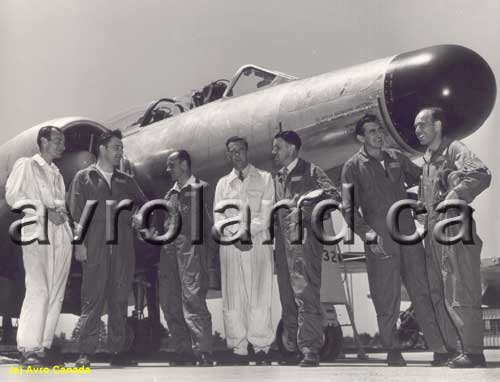      |

Dedicated to the people and projects of AVRO Canada & Orenda Engines Limited
CF-100 Canuck

left to right:
Peter Cope, Chris Pike, Jan Zurakowski (Zura), Mike Cooper Slipper,
Don Rogers, Stan Haswell, Glen Lynes (deceased 1955)
The photo above was donated by Stan Haswell, one of the original Avro
Canuck pilots. Stan was also involved in flying the Avro Jetliner and
Avro's DC-3; in addition Stan was one of the very few people who had
an opportunity to be a passenger in the AvroCar.
Out of the four
aircraft which were produced by Avro Canada, only the CF-100 Canuck
was privileged to go into full production. For thirty years the Clunk
as it was known affectionately served the Canadian Air Force, Belguim
was the only foreign country to use the Canuck.
Originally designatated at the XC-100, A.V. Roe Canada Ltd. was officially
approached towards the end of 1945 to design an all weather fighter.
The CF-100 was the 1946 brainchild of Edgar Atkin, then Chieft Engineer,
and John Frost, a designer from de Havilland in England who had worked
on the Vampire and 108 Flying Wing project (Frost was also the key player
in the AvroCar project) Initial armament requirements were for four
20mm Aden cannons but that was replaced by eight .50 Browning machine
guns; the nose radar was originally planned to be the British Mk.9A-1
but this was changed to the American AN-APS-19A. Avro was busy after
the war servicing Sea Furies, B-25 Mitchells and Lancasters; in addition
Avro was designing the Avro C.102 during the same time as they were
working the the Canuck, due to these factors it was not until mid 1948
that tooling was ready for the project, it was the end of 1949 when
the first prototype was completed. The prototypes were officially designated
as Mk.1s although they were never destined for military service.
Bill Waterton, on secondment from Gloster's of U.K., took #18101 (FB-D)
up for the first flight on the 19th of January 1950. As the Orenda engines
were not yet ready, a pair of Rolls-Royce Avons were used to power early
CF-100s. No major problems were noted in the first flight and the recommendations
of Waterton were for better nosewheel steering the improvements in the
air-break design.
The Second prototype 18102 (FB-K) was finished in July 1950 and introducted
the wingtip fuel tanks. This aircraft was delivered to the Central Experimental
and Proving Establishment in Rockliffe, Ontario in October of 1950;
18102 crashed around 10:30 am 5 April 1951 into some swampy land just
east of Highway 402 in Caradoc Township killing pilot Flight-Lieutenant
Bruce Warren, 28, of Toronto and Avro engineer Robert Ostrander of Brampton
(the crash happened the same day the aircraft was officially 'delivered'
to the RCAF).
The cause of the crash was attributed to the crew losing consciousness
at a high altitude, possibly from a oxygen mask failure. The prototype
aircraft was not equiped with ejection seats nor did it have controls
in the rear seat position.
Five Mk.2 CF-100s were produced (18103-18107) all fitted with the Orenda
2 jet engines. These aircraft were still not "production"
models but introduced the natural metal scheme instead of the high polish
black of the Mk.1s -- 18103 was used for the development of the underbelly
gun pack while the remaining Mk2s were built with dual controls and
designated as Mk.2Ts
The Royal Canadian Air Force began CF-100 operations in 1952 at R.C.A.F.
Station North Bay and the Canuck saw further modifications including
better radar, fire-contol system and upgraded engines. The CF-100 was
officially retired in October 1981.
The C-103 / CF-103 was a projected twin engined swept wing fighter,
proposed in May 1952 as a replacement for the CF-100, no orders were
placed and only a wooden mock-up was ever produced.
Information on the 16 Feb 59 crash of 18429
Information
on 18194 restored in Borden
From Canadian Aviation - January 1958: CF-100s to Belgium -- First batch of Avro CF-100s for the Belgian Air Force was delivered by the RCAF last month. The machines, 14 out of the total order of 53, were flown from the RCAF Station Uplands, Ottawa, by crews for 428 and 410 Squadrons. They went via Goose Bay, Keflavik, and Marville France, to Beauvechain in Belgium.
Check out a listing of the surviving Avro CF-100 Canucks
Check out a listing of ALL Avro CF-100 Canucks - feel free to contact us if you have more information to fill in the blanks
Check out Squadron Histories for units which flew the CF-100
Check out Squadron ID's for units which flew the CF-100
Check out information for other units which flew the CF-100
Check out mirror page 1 from Punchbowl Squadron
Check out mirror page 2 from Punchbowl Squadron
Check out mirror page 3 from Punchbowl Squadron
For photos of the CF-100 check out the Canadian National Aviation Museum
additional photos can also be found on Eric Dumigan's great site page 1 page 2 no longer online (was http://www.airic.ca/html/avro_cf-100.html)
We are currently looking to add information on the CF-100 demostration teams Bald Eagles & Red Ravens, if you have any material you would like to share please contact us.